Triumphal Way - new ideas
1997.01.15
...[the Triumphal Way] starts [sic] at the Templum Jani, and this is significant because of Janus' connection with Rome and war. Furthermore, the notion of Janus as beginning/ending is also significant, and the "way" beginning (and conversely ending) at Janus is complimented be the way ending (and conversely beginning) at the Area Martis.
Exhibit 1 text
1997.03.20
Life and Death within Piranesi's Ichnographia of the Campo Marzio
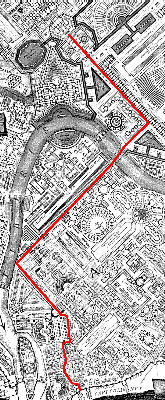
With a consistent dashed line, Piranesi demarcates the Triumphal Way through the Campo Marzio. The processional route begins, with historical and archeological accuracy, at the Templum Jani, which is situated at the bottom of the Ichnographia. The victor's march weaves through Rome's "theater district"--past small baths, shops, and brothels--and then continues on a long straight course towards the Tiber. Across the river, the procession turns behind the Sepulchrum Hadriani and approaches its end at the Templum Martis, the god of War and for whom the Campo Marzio is named. As the ultimate destination of the Triumphal Way, the Templum Martis is clearly among the most sacred, if not the most sacred, of places within the Campo Marzio, and, therefore, perhaps offers a key that lifts the Campo Marzio's "mask."
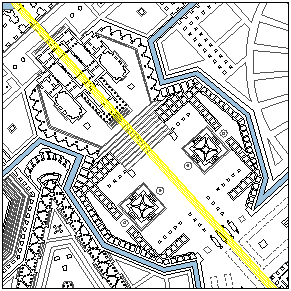
The Templum Martis fittingly promulgates overt manliness. Male genitalia boldly inform the Temple's plan, and the linear projection of the Temple's "endowment" manifests the Campo Marzio's longest straight axis.
As the axis of Mars spans from the Vatican Hill to the bend in the Tiber, it intersects the Campo Marzio's second longest straight axis, which bisects Hadrian's Tomb and the Bustum Hadriani. The perpendicular crossing of the two axes naturally creates a diametrical opposition. Geometry alone, however, does not represent the depth of their oppositeness.
The axis of Mars terminates at either end with a nymphaeum, while the axis through the Bustum Hadriani terminates at either end with an Imperial Tomb. The antithesis of nymphaeums and tombs is self-evident, and, therefore, attests to the axis of Mars representing life and the Bustum axis representing death.
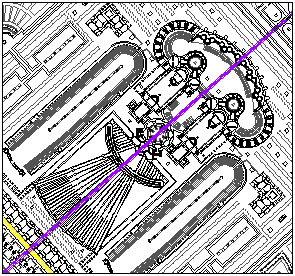
The Bustum Hadriani with its crematoriums and funereal banqueting halls, moreover, is nothing less that a gigantic "machine" to facilitate the passage from this life to the next. Yet, for all its architectural bombast, the Bustum Hadriani can in no way compete with the exalted simplicity of the tiny unnamed structure, which is behind the nymphaeum on the bank of the Tiber and at the very tip of the axis of life.
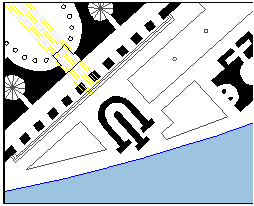
| |
architectural promenade
1997.08.05
...the new ideas re: the architectural promenade that developed because of the Danteum. Essentially, the Danteum has the same sequential series of architectural "events" as the formula for the architectural promenade that I have extracted from Le Corbusier and Stirling. The Danteum, however, adds the element of a journey from the profane to the sacred, and this addition significantly opens up the interpretive field and the buildings that can now be included as exhibiting the architectural promenade formula.
With regard to the profane/scared aspect, the triumphal way within Piranesi's Campo Marzio exhibits the same sequence. The procession (promenade) begins at the Templum Jani, a tetrahedron, which is the forest, the pilotis that raise the box. From there the route jaggedly marches through the "theater district" (downtown)--this is hell, the profane, the lower level. Just as the "way" approaches the Banks of the Tiber for the first time, the procession becomes straight and passes repetitive / monotonous buildings. The way remains perfectly straight except for two 90 degree turns, and this course comprises the greatest length of the promenade. (The straight portion of the procession passes, in sequential order, the Hecatonstylon and the outer niched wall of the Horti prius Pompejani deim Marci Antonii; then the long portico of the Stadium opposite the Domus Alexandri Severi; and across the river between the Porticus Hadriani and the Sepulchrum Libertorum et Servorum of the Bustum Hadriani. These buildings well exemplify the notion of inside/outside, thus tying the triumphal way more closely to the architectural promenade formula.) In the course of this long march, the procession crosses over from the area (of the Campo Marzio) that primarily represents life (inside/outside -- osmosis connection?) into the area that is primarily of death (the Bustum Hadriani). This is the same transition as in the Danteum's Purgatory, and the middle inside/outside level of the Villa Savoye (etc.). Ultimately, the Triumphal way ends at the Templum Martis, easily the most sacred place/space of the Campo Marzio. This culmination to the triumphal procession is analogous to the Paradiso of the Danteum, and to the solarium of the Villa Savoye (etc.). Of course, this has major implications towards my previous analysis of the Triumphal Way.
Campo Marzio - the triumphal way
1997.09.05
...an article in Ritual on the story/meaning of the Triumphal Way in ancient Rome. ...the route that Piranesi deliniated starts at the Templum Martis and continues until it enters the city at the Porta Triumphalis. ...have to reconsider the "profane to sacred" architectural promenade... ...the realm of the profane and the sacred did invert itself in Rome with the conversion to Christianity from paganism. Perhaps Piranesi is making a commentary on the reversal in ancient Rome's history and its meaning as a city. ...the Templum Jani sits at one of the ends (beginning?) of Piranesi's Triumphal Way, and this gives ground to the backward/forward reversal notion. Perhaps the whole notion of inversion is a dominant theme...
| |
life, death, and the triumphal way [inversion]
1998.01.11
I spoke with Sue Dixon yesterday and told her of my latest "discoveries" regarding the life and death axes of the Ichnographia, the arch of Theodosius et al and the further symbolism of the Porticus Neronianae as an inverted basilica-cross. She too became excited by my discoveries and then also brought further insight, especially in reference to the issue of the papacy and its research during the eighteenth century into the early Christian Church. She spoke of Bianchini and his nephew (a contemporary of Piranesi's) and their dual volumes of pagan (Roman) and Christian art, and she also mentioned how the papacy of the eighteenth century had lost (more or less by force and financial restraints) much of its political power and thus took on a very pious role--exhibiting not its worldly power but its almost mystical or spiritual power.
What I was saying about the apparent Pagan-Christian conversion-inversion narrative of the Ichnographia fit with what research Sue is continually doing regarding the contemporary and early eighteenth century influences on Piranesi and the whole issue of proto-archeology - history of the eighteenth century.
After speaking with Sue, I began thinking of the significance of the arch to the victory over Judea that is situated to the western end of the Bustum Hadriani. I now see it related to the pagan-Christian conversion-inversion of Rome, but in terms of Roman history it is a somewhat marginal issue-event. Yet, in terms of Christianity, the Roman victory over Judea, and hence the fall of Jerusalem, is a significant, albeit still sorrowful, event because of this event's relationship, and indeed verification of certain-particular passages of New Testament Scripture, i.e., Jesus' answering the Apostles question of when Jerusalem would end (which I think is in Mark or the Acts of the Apostles). Seeing how a seemingly minor event in Roman (Imperial) history can at the same time be a critical event for the foundation of Christianity made me think about how the Roman Judaic victory unwittingly gave manifest confirmation that Christianity had from that point forward absorbed Judaism.
Although it comes from the margin or edge, the significance of the victory of Judea arch sheds a major light upon the narrative Piranesi tells--Piranesi's "story" is about Christianity's similar absorption and concomitant destruction of paganism. This notion of Christianity absorbing both Judaism and paganism has major theological implications, especially with regard to a heretofore perhaps ignored importance-significance of Rome and the Roman Empire within the Canon and doctrine of the Christian (Catholic) faith.
...the real axis of St. Peter's Basilica and Square. This axis is fundamental to Piranesi' axis of life--and the most significant point alone the existing axis is the burial place of St. Peter, which, although not noted in the Ichnographia, is nonetheless an ancient Roman artifact.
...the story of the Triumphal Way. ...follow the triumphal path on the plan, and explain the entire route in Roman-pagan-triumphal ritual terms. ...bring up the essential concept of reenactment, the reenactment that Piranesi here designed, especially the well planned sequence of stadia and theaters along the way. Piranesi made use of what was actually once there.
When the route reaches the wall at the Temple of Janus, attention turns to Triumphal Arch-Gate, which is closed during the years of inactivity. Does the Triumphal Way then bounce off the wall and go back the way it came? Does the Temple of Janus allow us to go in either direction? (Other clues of inversion abound: obelisk in the Horti Salustiani, Porticus Phillippi, the Arches along the Via Lata, the Via Flaminia, the Circus Flaminia, the obelisks at Augustus's Tomb. The recurring inversion theme points to a greater meaning/symbolism.) The Temple (arch) of Janus represents the Arch of Janus built by Constantine (who might himself be called the Janus figure of Christianity) and this is the initiation of the way of Christianity's triumph: the profane to the sacred; the forest, hell, purgatory, heaven; the path of salvation through Christ and the Church.)
...the way from the profane to the sacred ends at the Area-Templum Martis as symbolic of the union of the most sacred site ancient Rome (or at least its point of origin) with the most sacred site of Christian Rome (St. Peter's place of burial) and also the point of origin of Christian Rome.
The garden of Nero is the ultimate field of inversion: Horti Neroniani to Vatican City, the garden of antichrist to the Church as the Body of Christ, the foremost seat of the Church of Christ, and finally St. Peter's inverted crucifixion begins the conversion of Rome.
I will conclude the inversion from pagan to Christian story-line by returning to the axis of death and the Arch of Theodosius et al at its tip, and thus when compared with the intercourse building we have depicted the beginning and the end of pagan Rome. To this I will add the Jewish Victory monument and end with the notion that Piranesi has here used architectural plans and urban design to tell the "history" of ancient Rome, however, one has in a sense read both the "positive" and the "negative" image-plan -- a story where the first half is the reciprocal of the second half (and vice versa). (I am oddly reminded here of the double theaters story from Circle and Oval in St. Peter's Square.)
Mistakes and Inversions
1998.02.19
...address Piranesi's own mistakes and inversions, particularly the inversion of the Circus Flaminius (which I now know to be also exchanged in location with the theater of Balba, which further shows Piranesi's intentional "mistakes" to make a specific point). [Perhaps,] Piranesi makes the mistakes, first to call attention to specific points, and second to highlight the notion of inversion. Piranesi is indeed being theatrical, which is only natural because of the whole notion of reenactment. ...discuss the Ichnographia's Triumphal Way and how Piranesi redesigns (reenacts) the Way making it more ideal to its purpose (marching through the theater district). The Way (within Ichnographia at least) ends at the Temple of Janus--a perfect example of inversion. Then following the Triumphal Way in reverse manifests the Christian theme of salvation and redemption, ending at the inverted "basilica"--the upside-down "inverted" crucifixion of St. Peter. ...the Ichnographia not only represents the history of ancient pagan city of Rome, but also the Christian city of Rome. This evokes Augustine's The City of God and also Bloomer's notion of the Ichnographia transcending time.
...the Scenographia as the stage upon which Piranesi reenacts--this is the first scene and the "play" is about to begin. In the course of the "play" the most egregious "mistake/inversion" is the misplacement and disorientation of the Circus Flaminius and its actual exchange with the Theater of Balba. This "mistake" manifests a composition of inverted theaters--essentially a double inverted theater. This configuration becomes one of the Il Campo Marzio's final scenes and thus represents the double inverted "theater" of Rome's own history--the narrative of pagan Rome and the narrative of Christian Rome, and in the Ichnographia the one story is indeed a reflection of the other.
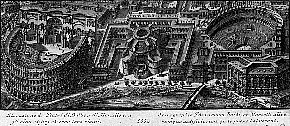
|